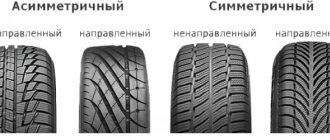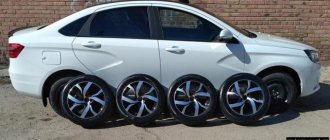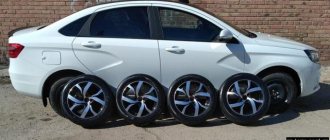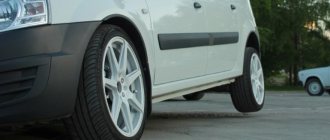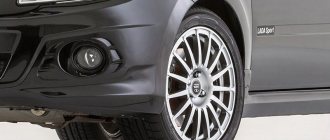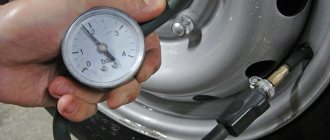How often to measure to kill rubber
Please note that pressure may change due to changes in ambient temperature.
Moreover, the process occurs equally in winter and summer. The main rule when checking is to measure it before driving, before the tires get hot. After a short trip, the wheels become very hot and the performance differs significantly from the real ones. Measurements should be taken not only after tire wear has become noticeable. The manufacturer recommends checking the inflation when you feel that the car is behaving differently.
For example, it began to throw to the sides, uncertainly when entering turns. In any operating book you will find information that a check must be carried out if temperature changes reach 10-15 degrees.
As a rule, these are the spring/autumn seasons, be careful this is a time of temperature fluctuations.
Features of choosing a tread
First of all, here you need to start from the operating features of the vehicle. Low-profile tires are also suitable for urban conditions. If you plan to drive on dirt roads or off-road, then you will have to take higher tires. In addition, the noise level of the tires should also be taken into account. To make the ride more comfortable, you should pay attention to soft tires.
Based on the type of pattern, there are four types of protectors:
- symmetrical directional. The best option if you plan to drive at high speeds. At the same time, the models are resistant to aquaplaning. This pattern is well suited for high-quality drainage of water upon contact. The main disadvantage is high noise;
- symmetrical non-directional. A universal option that maintains an optimal balance between efficiency and comfort. Perhaps the water drainage rates here are not the highest, but the tires are quite good for slow water. At the same time, it will be comfortable to drive both on gravel and on the highway;
- asymmetrical non-directional. The outer part is characterized by increased rigidity, while the inner element is designed for improved drainage. The center of the rubber is designed in such a way as to increase directional stability. The disadvantage comes down to poor absorption of vibration vibrations due to the rigid center and external element;
- asymmetrical directional. Such models are the most difficult to come across, since they are practically not produced now. The elements were produced in order to smoothly distribute the load over the entire surface of the tires, as well as ensure the highest quality drainage. At the same time, car owners had to carry two spare tires with them, which led to a decrease in demand for this option.
It will also be interesting to read: What is the difference between the Lada Vesta SV and the new SV Cross model?
It is worth noting that there is no ideal option here; each type of tire has its own advantages and disadvantages, so the choice must be made based on the driving style, as well as the operating conditions of the vehicle.
Low profile tire pressure
This parameter, ignored by novice car enthusiasts, is very important when operating cars with any tires, and especially with low-profile ones. The required tire pressure is always indicated by the vehicle manufacturer in the operating instructions and in an accessible place on the body, for the Lada Vesta - on the B pillar on the driver's side.
- Low profile tires require increased attention to pressure, as insufficient pressure will make the wheels and suspension even more vulnerable to potholes and rocks on the road.
- As many years of experience have shown, the pressure in low-profile tires must be maintained 15% higher than that specified by the manufacturer for wheels of the recommended size.
What tire pressure is needed for Vesta SV Cross
Well, we’ve sorted out the wheel markings, let’s move on to such an important parameter as pressure. Pressure is measured in atmospheres and factors such as:
- vehicle handling;
- comfort when moving;
- tire durability;
- disk integrity.
You may also be interested in: The best chargers for a car battery
Too high tire pressure when driving, especially on rough roads, will lead to early tire failure due to wear of the tread in the central part of the wheel.
At the same time, low pressure will ensure a smooth and soft ride of the car. However, a car with such wheels is less controllable at high speed. In addition, there is a possibility of increased tire wear along the edges of the wheel. The rims of your car may also be damaged.
When driving into a hole, tires with low pressure will not be able to provide the necessary protection, which may cause part of the disk to bend.
What tire pressure should I choose for the Lada Vesta SV Cross? Recommended values are 2.1 - 2.5 atmospheres. The pressure is selected based on the driving style and the required driving comfort. However, you should not go beyond the recommended parameters.
Tire pressure Lada Vesta
If you don’t know what pressure is in the Lada Vesta tires, then this article will answer your question.
Please note that it is necessary to check tire pressure quite often, as this directly affects driving safety. Manufacturers also set standards for each specific car so that the driver has something to focus on.
The Lada Vesta instruction manual contains the following values:
| Vehicle modification and execution | Tire size with load capacity and speed indexes* | Wheel size | Air pressure in tires front/rear, MPa (kgf/cm2) | |||
| Rim width (inches) | Rim offset (et)**, mm | Partial load*** | Full load**** | |||
| Installed by the manufacturer | ||||||
| "sedan" version | All modifications | 185/65r15 88h 195/55r16 91h | 6j | 50 | 0,21/0,21 (2,1/2,1) | 0,2/0,22 (2,1/2,1) |
| Allowed to be installed during operation | ||||||
| "sedan" version | All modifications | 185/65R15 88T, H 195/55R16 87.91T, H | 5J, 5½J, 6J 5½J, 6J, | 50 | 0,21/0,21 (2,1/2,1) | 0,21/0,21 (2,1/2,1) |
New Lada: Asta la “Vesta”, baby: The concept of the frame LADA Vesta SW Cross has been presented – the network is delighted
* Speed indices: T – up to 190 km/h, H – up to 210 km/h. Load capacity indices: 88–560 kg; 91–615 kg. **Rim offset (ET) is the distance from the mating plane of the disc to the middle of the rim. *** Partial load – no more than 3 adults in the car without cargo in the trunk.
**** Full load – more than 3 adults or 3 adults and a load of 50 kg in the trunk.
Deviation from these recommendations will lead to dire consequences:
- The stability and controllability of your car will deteriorate;
- Fuel consumption will increase due to greater tire resistance;
- Tire wear will increase.
If you don’t want to memorize the table, then on the Lada Vesta the recommended tire pressure values are indicated on a special information plate, which is located on the B-pillar on the driver’s side. Just open the driver's door and find out the recommended tire pressure for the Lada Vesta.
If the pressure constantly drops, then it is necessary not only to pump up the tires, but to eliminate the source of the leak. First of all, you should check the spool; if it is working, then the problem is in the tires or wheels. You may have a puncture or a loose fit between the tire and the rim.
Note that the air pressure in tires is constantly changing, depending on the temperature of the air inside the tire. At low temperatures, air compresses and pressure drops; as temperature rises, pressure increases.
It is optimal to check the readings at an ambient temperature within 10-15 degrees Celsius and after a short period of inactivity. When driving, the tires warm up, so measuring the pressure immediately after a trip is incorrect.
Brief overview, price and photo
Lada Vesta SV Cross station wagon of the first generation
Lada Vesta SV Cross station wagon (Lada Vesta SW Cross)
The first generation has been produced since the fall of 2021 at the LadaIzhevsk plant, which belongs to PJSC AvtoVAZ. Lada Vesta SW Cross is an “off-road” version of the Lada Vesta SV station wagon. The main differences of the “off-road version”: increased ground clearance from 178 mm to 203 mm and the presence of a plastic body kit around the perimeter. Also, the Lada Vesta SW Cross station wagon has original springs and shock absorbers and the ability to choose an interior with orange inserts. The platform is the same as that of the sedan - Lada B/C. Lada Vesta SV Cross is equipped with two petrol 16-valve engines: 1.6 (106 hp) 21129 and 1.8 (122 hp) 21179, two gearboxes: 5-speed French manual 5MT or 5-speed VAZ robot 5AMT. The Lada Vesta SW Cross has only front-wheel drive; there are no plans for an all-wheel drive version. Manufacturer's warranty: 3 years or 100,000 km, for body parts 6 years against through corrosion.
Hub hole diameter (d)
Some manufacturers produce wheels with an oversized hole diameter for the hub - this circumstance allows them to be used using special inserts - centering rings on many car models. Therefore, a larger hole diameter for the hub is an easily solvable problem, in contrast to the opposite situation, when the hole is small.
And yet, there is a common situation when bolted fastening seems sufficient to the car enthusiast, and the use of centering rings is neglected. In this case, at speeds above 100 km/h, wheel runout begins, which can be difficult to diagnose, and pointless balancing costs follow.
How many atmospheres to pump the wheels on the Lada Vesta Cross - instructions
The factory recommendation for Vesta Cross indicates from 2.2 to 2.4 “atmospheres”, this also depends on driving style. The size plays a role, considering that the manufacturer installs R17 wheels and size 205/50.
New Lada: All details about the Lada Vesta Cross Concept - Uncategorized - Motor
Some people want a higher, wider tire, so they “play” with the inflation level as they want. But, you need to take into account all the features, what the load is, the diameter, the larger the diameter, the smaller the height.
It is generally accepted that for the Cross version the average values range from 2.2 to 2.4 atmospheres.
What do tires affect?
It is worth noting that car tires play a very important role. This element affects such parameters as:
- maximum speed and acceleration of the car;
- controllability and braking distance;
- amount of fuel consumed;
- wear of the chassis, etc.
Thus, it is very important to carefully select tires, and also use only those tires that are provided by the manufacturer.
What non-standard sizes can be supplied?
In addition to the standard wheels listed above, you can install tires of non-standard diameter on your Lada Vesta. When choosing such solutions, you should definitely adhere to a number of recommendations:
- when using rubber with a diameter of 15 inches, the tire composition must have increased strength - since the car will have greater inertia when cornering;
- for aggressive, fast driving - wheels with a diameter of 17 inches are best suited;
- Summer tires are best equipped with wheels with a diameter of 16 inches - such wheels can be equipped with tires with a sole width of 185 to 195 mm and a profile height of 55-60 mm.
Before installing and starting to use tires of non-standard sizes, the driver should “try on” them. Often, when the wheel width or profile height increases, the tread begins to touch the plastic fender liner.
As a result, the fender liner itself may be broken, and the protector begins to quickly wear down on the plastic surface. Wheels that are too large often damage mudguards and the body.
The appearance of cracks and chips in the paintwork causes serious trouble.
Lada Vesta tire size
The manufacturer installs tires of two sizes on the Lada Vesta car:
- 185/65/R15
- 195/65/R16
195/65/R16 tires are installed on 16-inch alloy wheels, and 185/65/R15 tires are installed on 15-inch wheels, which you can see in the photos above. In its recommendations for choosing tires for Vesta, the plant also did not distinguish itself with originality and offered the options already mentioned above. However, for those who want to install larger tires on their car, for example, size 205/55/R16, there will be no disappointments, because the tire also easily fits into the right place and does not catch anything. Experimenting with larger sizes is not recommended.
Unsuitability of disks of other models of the Lada line
Wheel rims of size 185/55/R15 from the AvtoVAZ Grant, Priora and Kalina models cannot be installed on the Lada Vesta, even though at first glance they seem suitable. The diameter of the hole for the wheel hub of these cars is 58.5 mm, that is, 1.6 mm less.
But, even if this hole is bored on a lathe to the required size, the bolt pattern (PCD) of these products is 4x98, not 4x100, and 3 of the four mounting bolts will not be centered relative to the mounting holes, accordingly, the disk will not be aligned with the hub, and its rotation will be accompanied by beating.
Standard tire pressure monitoring system for Lada vesta
At the moment, this system is available - it is installed on export versions of the Lada family: Vesta, XRay, Kalina, Granta. It’s hard to say when the option will appear on Lada models intended for Russia; the fact that the option is available is encouraging. Perhaps soon the “gadgets” will be available here too.
Taking into account the equipment of export vehicles, their “tidy” is also different, because this is where information from the sensors is sent. In general, the TPMS tire pressure monitoring system is represented by four built-in sensors in the wheel valves. TPMS sensors regularly measure and send data to the dashboard, informing the driver.

